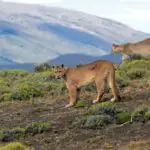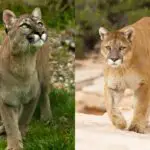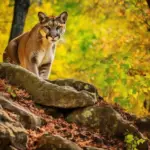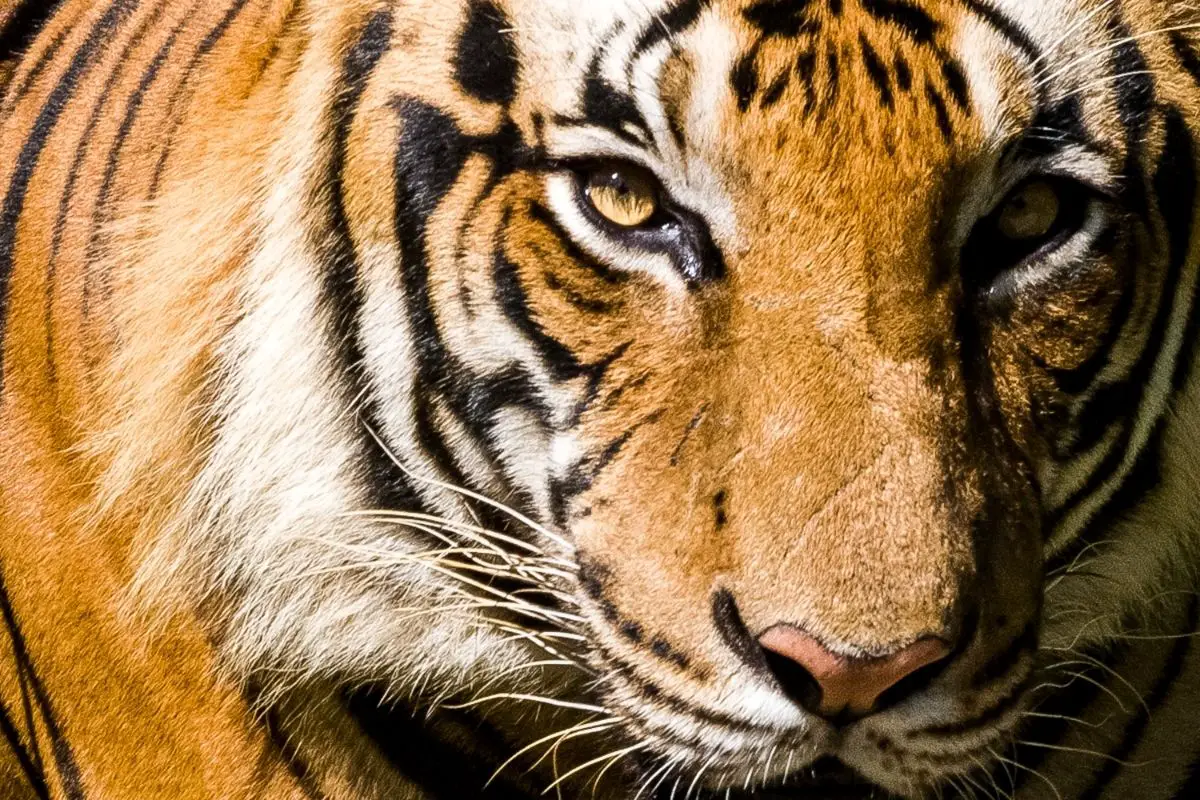Mountain lions are extremely widespread animals in the Western hemisphere.
These cats are most known for their presence in North America, which some love or hate.
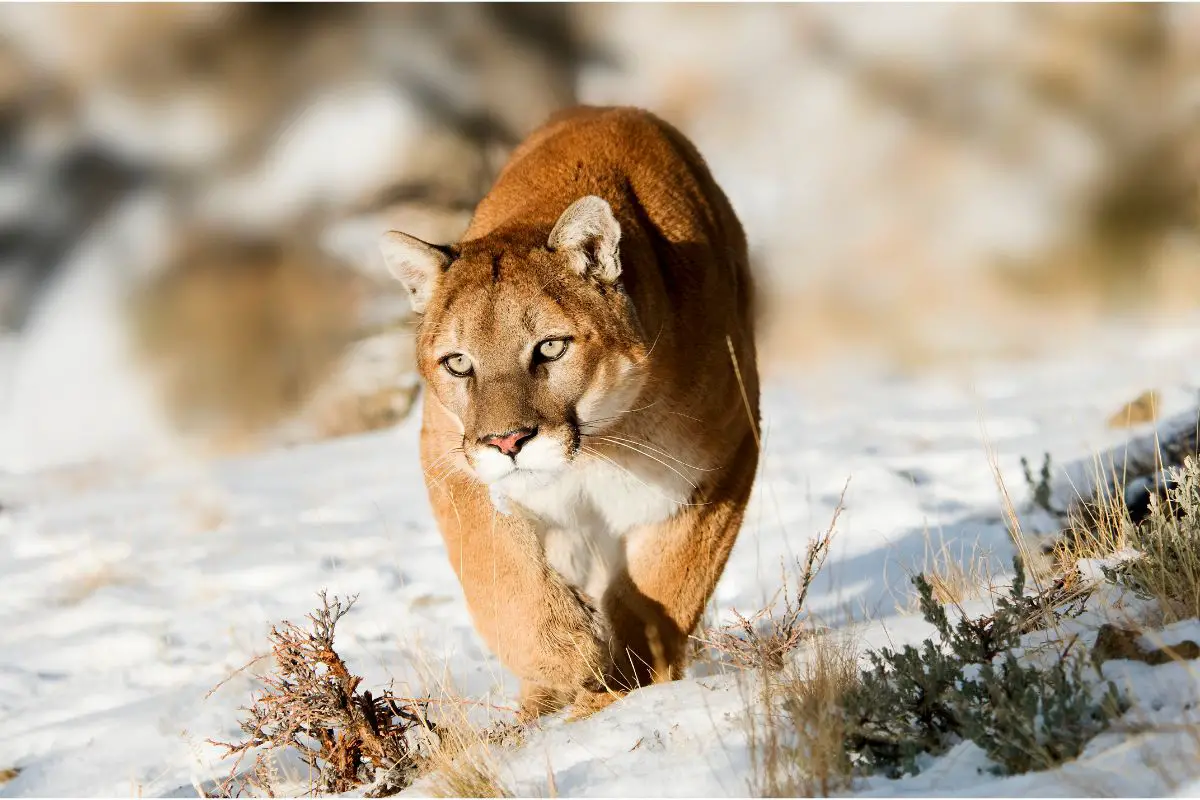
If you want to learn all about the mountain lion, just stick around.
We are going to be going through everything you need to know.
This includes all the basics, their appearance, names, habitats, behaviors, conservation, and even their hotspots and world records.
We will also be taking a look at the impact of mountain lions on the United States, including for farmers, hikers, and the environment.
If you are interested in finding out about all this, then buckle up!
Mountain Lions: Everything You Need To Know About Mountain Classification
- Also Known As: mountain lion, puma, cougar, panther, catamount, red tiger, deer tiger, painter
- Average lifespan In The Wild: 10-13 years
- Scientific Name: puma concolor
- Genus: Puma
- Family: Felidae
- Order: Carnivora
- Class: Mammalia
- Kingdom: Animalia
- Phylum: Chordata
- Height: 2-3 feet
- Weight: 64-220 lbs
- Length: 3.25-5.25 feet (head and body); 23.5-33.5 inches (tail)
- Conservation Status: varies depending on subspecies, typically least concern (population decreasing)
- Number Of Subspecies: seven living subspecies, one extinct
Understanding The Names Of The Mountain Lion
All the names of the mountain lion have led to a lot of confusion.
Many people are unsure of whether a puma and mountain are the same thing, or a cougar and a puma. The answer is yes.
No matter which name you hear, they are referring to the mountain lion found across North and South America.
The reason for all these different names is due to the wide range that this animal has.
The name used for these animals will vary depending on where the animal is located, or who is describing it.
Names have come from settlers as well as native languages from the Americas.
Throughout this article, we will be referring to mountain lions as pumas and cougars as well.
While these animals are sometimes also known as panthers, we will not use this term as it can create confusion.
This is because the jaguar is also known as a panther, and this term is used less frequently to describe a puma.
If you want to find out more about this, feel free to check out our blog looking at the differences between a mountain lion and a panther.
There are also plenty of other articles that look at similar things on our site, so take a look around!
Appearance And Characteristics
The puma is a large, tan cat with a white belly and chest.
Their color can vary slightly depending on where in the Americas they are.
However, they will always be a shade of tan or a tawny brown unless they have a mutation.
Some mutations can cause animals, including cougars, to be black, white, or another variation.
Besides their recognizable tawny coloring, a mountain lion will also have black markings.
These markings will be around the animal’s snout, the tips of their ears, and the tip of their tail.
Adults have eyes that can appear to be a green-brown or yellow color.
This coloring will eventually appear when a puma is about a year and a half old.
There are no other noticeable markings on an adult mountain lion that will set them apart from other cats.
Mountain lion cubs, however, have a very different appearance from their parents.
These cubs will be covered in black spots to help them blend into their environment.
They have the same tan or tawny colored fur as their parents, but have more black on them.
There is more black on their faces, including their snout and above their eyes.
Cubs also have noticeably blue eyes that change as they get older.
The sizes of mountain lions can vary greatly. Typically, the larger animals are closer to the poles and will be in counties like Alaska and Argentina or Chile.
Closer to the equator, in countries like Colombia, Ecuador, and Brazil, cougars are usually a little smaller.
These animals typically only reach lengths of around 5 feet, and their tails are between 23 and 33 inches long.
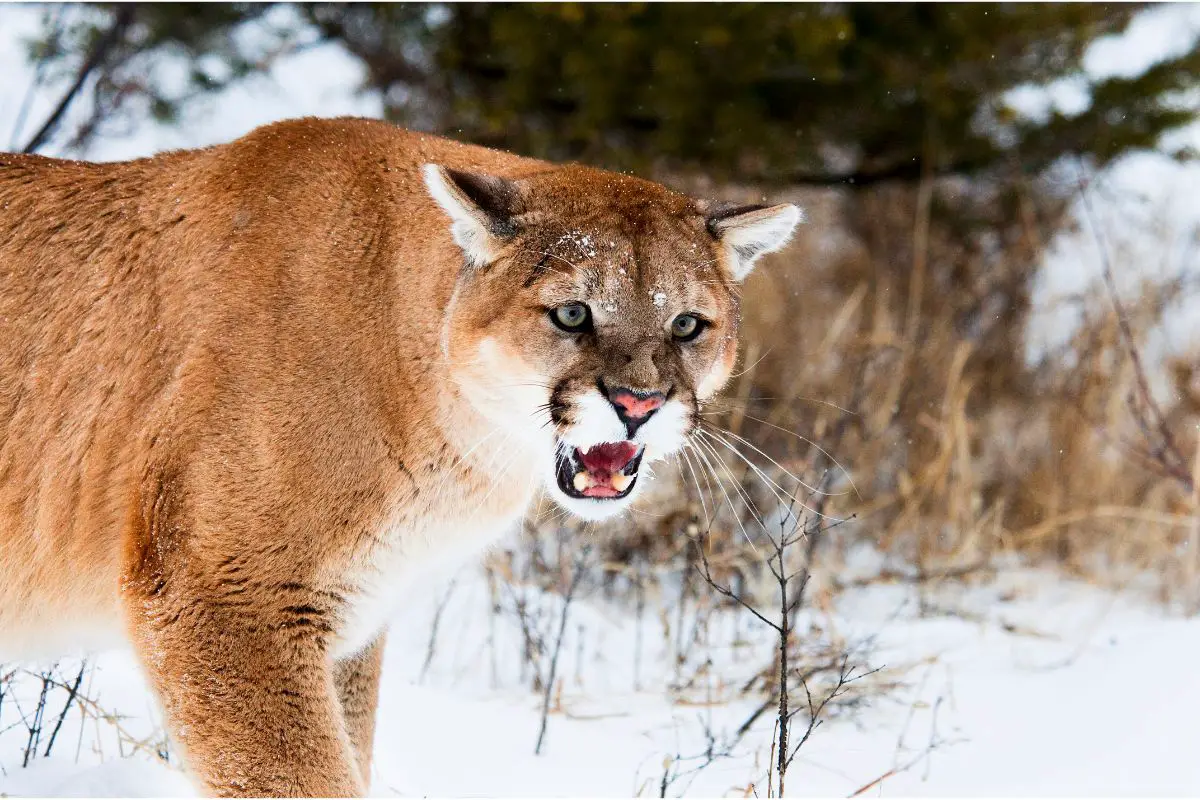
Up to the shoulder, mountain lions can measure up to a maximum of three feet, and they can weigh up to 220 lbs.
It should be noted that many pumas will be slightly smaller, as these numbers are on the upper limit.
Female cougars are also smaller than the males. The females are more likely to weigh up to 120 lbs, and are generally about ⅓ smaller than the males.
Sounds And Calls
Pumas are known for making a range of sounds, but they cannot roar.
Instead, a mountain lion will growl and hiss, much like a house cat.
They will also purr! Both males and females are known for their terrifying “scream” that you may have heard before.
This scream is incredibly shrill and loud, and sounds almost identical to a woman’s scream.
This scream is probably the most well-known sound of a cougar, and is always something to look out for if you are out.
For female cougars, this scream is thought to indicate that they are ready to mate and is done to signal that to males in the area.
Cougar cubs can hiss and make chirping sounds. This chirping is thought to be a way of them locating their mother.
Habitat And Range
Mountain lions cover an extreme range – all the way from Alaska to Argentina and even southern Chile.
Because of this, they can thrive in a variety of ecosystems as long as there is prey and shelter at their disposal.
It would not be unusual to see mountain lions anywhere from mountainous regions to deserts, forests, and wetlands.
No matter where they are, cougars typically prefer to stay away from humans and too much development.
There have been instances, however, where mountain lions are seen close to cities, or in city suburbs.
While alarming, it is important to remember that we as humans are the ones who have been gradually reducing their natural areas.
For example, cougars are primarily native to the West in the United States.
States like California, Washington, and Nevada are relatively well built-up, which has infringed on the mountain lion’s habitats.
This destruction of habitat means that we are living in mountain lion territory, and coming across them occasionally is expected.
It is also important to note that the historical distribution of mountain lions used to be far wider than it is today.
These animals used to be found throughout the United States, including the East coast and along the US-Canadian border.
Over the years, however, this range has shrunk considerably, and these beautiful animals are now only in small pockets of habitat.
Because of this, it’s important to sympathize with mountain lions and understand that they are not living in our land, but we are in theirs.
One of the few places where you can find mountain lions that isn’t on the West Coast is southern Florida.
Here, there is a small population of a subspecies of cougar that are colloquially referred to as “Florida Panthers”.
To tell the difference between a mountain lion and Florida Panther, you would have to look closely at the animal’s back and tail.
The Florida Panther’s tail is slightly crooked, and they have a patch of fur on their back that resembles a cowlick.
However, because both the Florida Panther and mountain lion are both mountain lions or cougars, the differences are minimal.
This is usually the case with subspecies, as the primary things that separates them are their distribution areas.
The majority of mountain lions in the United States are found in desert or dry habitats, as is the normal in states like California.
They are also in forested areas in states like Washington, and wetland areas like in southern Florida.
In South America, many mountain lions can be found in mountainous areas, as their name suggests.
These South American subspecies also do well in valleys and gorges, swamps, marshes, and thick broadleaf forests.
Once again, wherever there is prey and shelter for these animals, they are likely to do well.
Behavior And Diet
Cougars are solitary animals. This means that they live alone and have their own territories.
The only time that these animals don’t live alone is during the mating season and when the female is caring for her cubs.
When solitary, these animals need between 50 and 125 square miles to roam, with males preferring more space.
In terms of diet, mountain lions are obligate carnivores, like other cats.
This means that they can only get the nutrients they need from meat rather than vegetation.
This does not mean that they cannot eat other food types, but simply that they would not get the benefit of doing so except for the pleasure of it or the flavor.
These animals are excellent hunters, and have been known to prey on anything from deer and elk to mice and birds.
They are stalking animals, and will lie in wait for prey to get close enough before pouncing and killing.
To kill their prey, a mountain lion will deliver a lethal bite to the animal’s spinal cord.
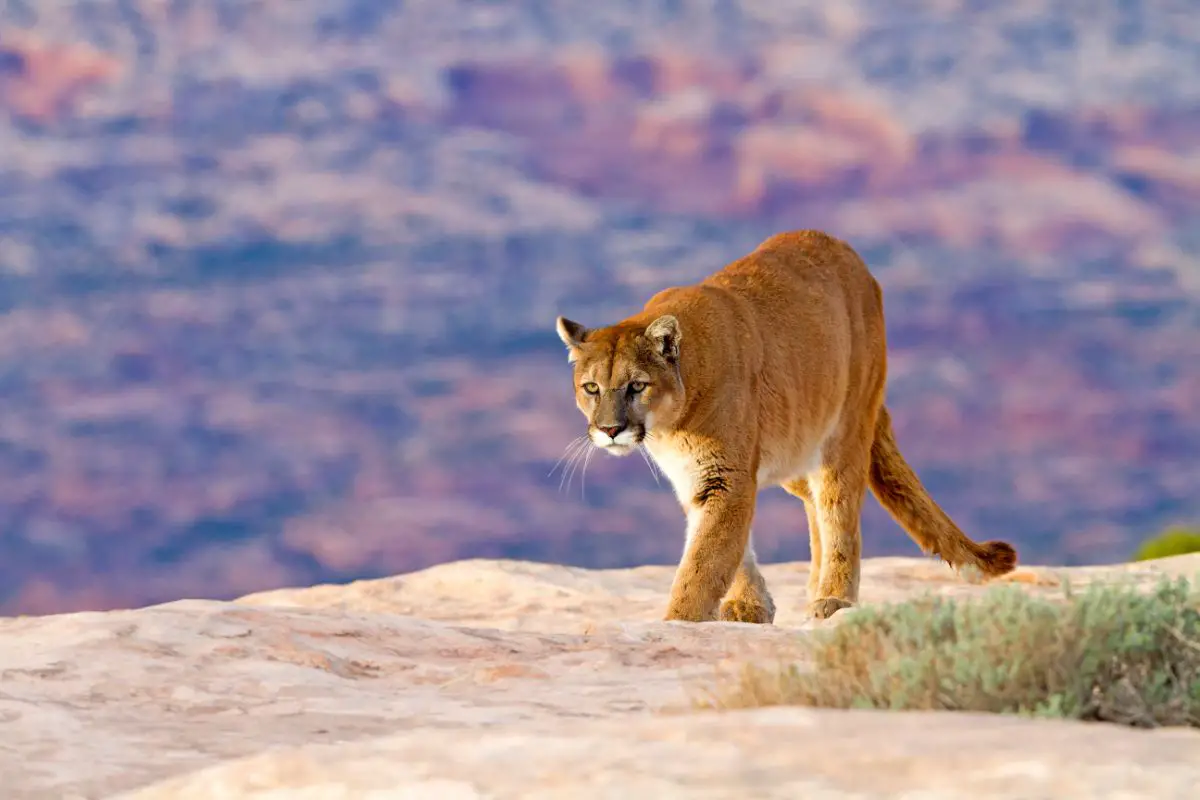
This way of killing is somewhat unique to the puma, as the majority of cats kill their prey by suffocating it.
Suffocation is usually done by clamping down on the throat of an animal.
Other cats, like jaguars, are known to kill their prey by delivering a bite to the back of the skull to kill their prey instantly.
Once a mountain lion has eaten as much of the prey as they can, they will “cache” it.
In other words, they will hide it beneath leaves and twigs to return to it at a later time.
Because of the presence of other animals such as coyotes, however, the animal does not always return to the carcass as they left it.
Breeding
Unlike many other animals, there is no set breeding or mating season for mountain lions.
Mating can happen at any time of year. However, the majority of mountain lion births take place in the late winter or early spring, but this is certainly not always the case. Females will breed every two years.
These animals have a gestation period of 90 to 96 days.
When the mother is ready, she will typically give birth to anywhere between 1-5 cubs.
These cubs will then stay with her until they are ready to live on their own.
This is usually until they are around 15 months, or little over a year old.
However, some cubs will stay with their mother until they are over two years old before venturing off on their own.
Cubs are born with black spots and blue eyes to help them blend into their environments.
They will rely on the milk from their mother until they are between 4-6 months old.
However, when they are 7-9 weeks old, the mother will begin to introduce them to meat by taking them to her kills.
This is a gradual process, and will take longer for some cubs to get the hang on than others.
At 2 to 3 years of age, a female cougar will begin breeding.
Males will also only begin to breed when they are sexually mature at around 3 years old.
Both males and females will only start breeding when they have established a permanent home territory, likely for safety reasons.
Conservation
Because of the mountain lion’s extreme habitat loss over the years, their numbers have decreased significantly.
While they are not yet considered to be endangered, their falling numbers are cause for concern.
It is important to note that this conservation status is for cougars as a whole.
When looking at subspecies of mountain lions, there are various statuses to consider.
Just over a decade ago, in 2011, the eastern cougar was officially declared as extinct.
The Florida Panther, a subspecies of mountain lion we mentioned earlier, is listed as being endangered.
It is thought that there are between just 120-130 of this subspecies left in their wild habitat today.
Below are the known subspecies of the mountain lion.
Please note that the conservation status of these animals may need to be revised in the future as the status of these animals changes.
- North American Cougar (Puma Concolor Cougar) – least concern
- South American (Andean) Cougar (Puma Concolor Concolor) – least concern
- Florida Panther (Puma Concolor Coryi) – endangered
- Costa Rican Cougar (Puma Concolor Costaricensis) – least concern
- Eastern Cougar (Puma Concolor Cougar) – extinct
- Eastern South American Cougar (Puma Concolor Anthonyi) – least concern
- Chilean Cougar (Puma Concolor Puma) – least concern
- Argentine Cougar (Puma Concolor Cabrerae) – least concern
Despite the United States’ population of mountain lions primarily being on the West Coast, there are a number of habitats in the east that would be suitable for them.
Since 1977, despite this animal not being threatened or endangered, it has been listed on the Convention of International Trade in Endangered Species of Wild Fauna and Flora Treaty Appendix 11.
This has stated that trade control has been needed in order to avoid the population from being threatened.
In 2019, the cougar populations in Panama and Costa Rica gained Appendix 1 designation.
This means that trade will only be permitted if there are exceptional circumstances.
Appendix 2, on the other hand, states that trade control is needed to avoid threatening the survival of the species.
There are four primary reasons why the mountain lion’s population has decreased over the years:
- Hunting – fear-based hunting is common, especially for farmers in order to protect their livestock. Though hunting cougars is banned in states like California, and punishable in Florida, hunting is still common.
- Habitat Loss And Fragmentation – mountain lions need a considerable amount of space in order to be happy. Because of humans spreading out and taking land away from these animals, their habitats are shrinking and being fragmented. Pumas like to be in areas with ample shelter and prey, and this has resulted in them moving to different, more suitable locations, or dying off.
- Less Prey Availability – statistics show that between 60-80% of a mountain lion’s diet is made up of deer in most of the United States. Although these animals are capable of hunting larger prey, they typically do not prefer it. With urbanization growing, there is less wildlife for these animals to prey on and feed on. This has resulted in animals moving to different locations, or dying off.
- Road Mortality – with more vehicles across the globe, this has had a huge impact on the populations of cougars. Not only do vehicles and roads lead to animals being hit and killed, but it also puts animals off moving, mating, and hunting. Over the past few years, it has been found that 28% of cougar mortality was due to vehicle collisions.
World Records And Facts
- The Most Names – the cougar holds the world record for an animal species to have the most names! In the English language, this animal has more than 40 names, though “puma” is the most common in many parts of the world.
- The Biggest Cougar – the largest cougar ever recorded weighed an incredible 276 lbs. The maximum size a male cougar typically reaches is around 220 lbs. This massive cougar was found in Bryce Canyon National Park in 2014.
- The Oldest Puma – the oldest puma recorded so far has lived to the ripe old age of 22 years. In the wild, most cougars will live for up to 10 years, and in captivity, roughly 20 years.
- The White Cougar – a young white cougar male (albino) was discovered in Brazil recently. This is an extremely rare sight, as few white cougars have ever been recorded.
Mountain Lion Hotspots In The United States
There are few mountain lion hotspots that we know of.
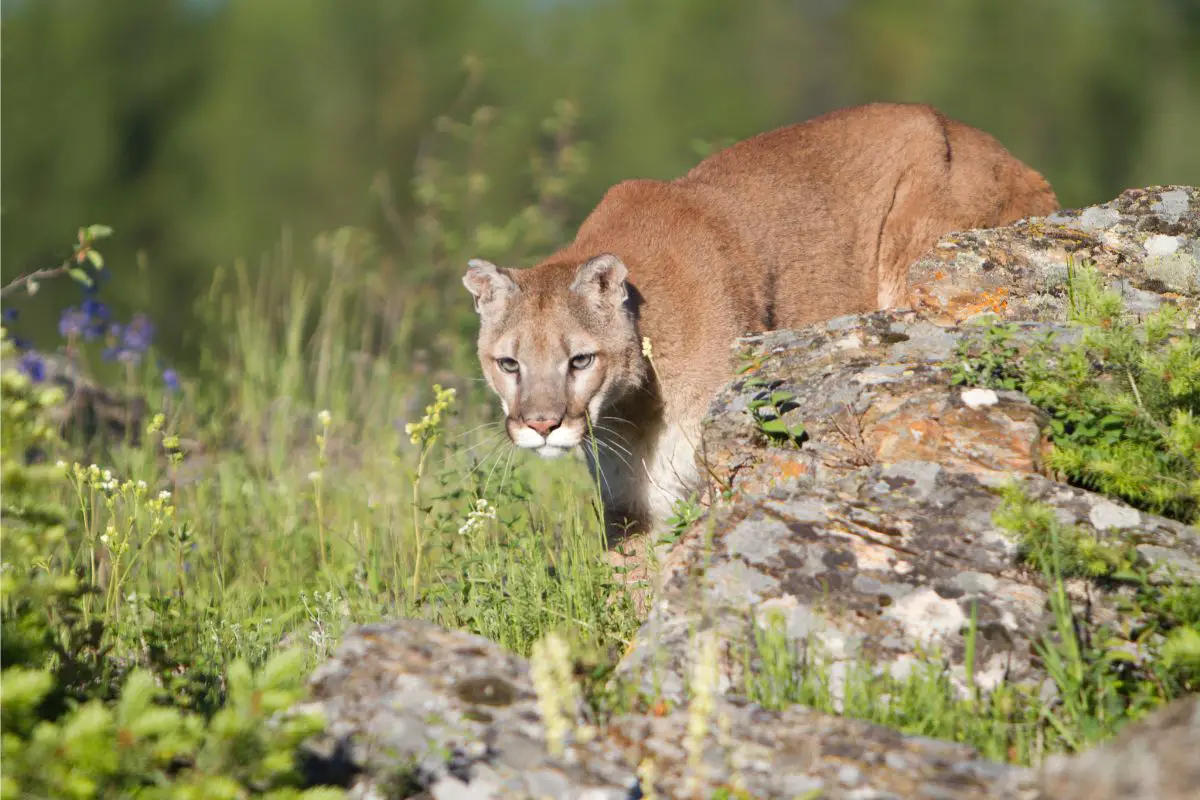
However, it is thought that both California and Colorado have the highest estimated populations of cougars within the US.
Instead of looking out for hotspots listed for mountain lions, you should consider finding habitat that is perfect for them.
Look for areas that have a lot of deer or smaller animals that could be a cougar’s prey.
On top of that, ensure that the area isn’t too close to cities and towns, since these animals prefer to be left alone.
Mountainous areas are ideal for pumas, and you are likely to find them there.
Any areas that have caves or other forms of shelter will work as well.
In South America, there are a number of known areas where pumas roam.
The Purcell and Cabinet Mountains have healthy numbers of cougars, and are unfortunately used for hunting frequently.
The Impact Of Mountain Lions On The United States
Mountain lions have a much more severe impact on the world than many people care to admit.
These impacts are both positive and negative, but the positivity far outweighs the negative in this case.
If you want to learn about the impact of mountain lions on the United States, take a look at the sections below.
Are Mountain Lions Dangerous?
This should go without saying, but yes – mountain lions are dangerous.
They are large cats that feed on prey much like lions and tigers, though smaller.
These animals are incredibly strong and hardy.
They have claws and canines that are over two inches long, which can easily kill both animals and humans.
However, it should be noted that, while these animals are objectively dangerous, they do not necessarily pose a huge risk to people.
This is because they prefer to keep their distance from people rather than go after them and hunt them.
Of course, there are always exceptions, and people have been known to be attacked by mountain lions.
These attacks have rarely proven fatal, and there have been only two confirmed fatalities in the past century in Washington. The first fatal attack was in 1924, and the other in 2018.
In the whole of North America, there are thought to only have been 27 or so cougar attacks that have ended in deaths in the last 100 years. There have been around 130 attacks in that time.
As you can see from the numbers, it is extremely rare for cougar attacks to occur, and even rarer for them to be fatal.
Not only that, but the number of attacks seems to be dropping as time goes on, a sign that these animals are likely being pushed further and further from their natural habitats.
The majority of reported attacks, some of which may be false, have been on children.
This is especially the case when it comes to fatal attacks, as many victims have been between the ages of 3-13.
Some states, like Oregon, only reported their first ever fatal cougar attack in 2018.
Mountain Lions And Outdoor Activities
Many of the mountain lion attacks that have been reported have involved hikers or cyclists.
The vast majority of people who have experienced any kind of attack, or even an encounter, with a mountain lion have done so while out in the wilderness.
Since hiking on trails and mountain biking are extremely popular and take you into mountain lion territory, it isn’t difficult to understand the reason for these numbers.
However, considering the millions of people who enjoy hiking, cycling, mountain biking, and other outdoor sports every year, the number of attacks are still extremely low.
There have been very few reported attacks that have not taken place on trails or national parks.
A small number of attacks and fatalities have been reported in suburbs such as Sacramento, where a 5-year-old was killed while riding his tricycle in 1989.
When these attacks happen, the animal involved is tracked down and exterminated.
Protecting Yourself Against Mountain Lions
If you are going out into an area where there are mountain lions, it is crucial for you to protect yourself.
Carrying bear spray or pepper spray works wonderfully in these scenarios and should always be in reach.
However, while these are both effective tools if you can see that a mountain lion is coming, they may not always work.
These animals are known for their stalking ability, and you may never see one until it is literally on top of you.
Because of this, it is crucial for you to always be aware of your surroundings and never jog with earbuds in.
That is the perfect way to allow something – human or animal – to sneak up on you and catch you unawares.
If you do find yourself face-to-face with a mountain lion, there are some important things for you to remember:
- Make yourself look as big as possible
- Be loud
- Don’t turn your back
- Don’t antagonize or corner the animal
If you are on a hike and have trekking poles, you should lift them over your head and appear as big as possible.
As soon as a cougar realizes that you are too much work, or even realizes that you are a human, they are unlikely to be interested in continuing.
If you are attacked by a mountain lion, the most important thing to do is fight back.
There have been cases of people being attacked by mountain lions and coming out alive just using a ballpoint pen.
You can use a pen, a rock, knife, stick, or anything else that is hard that you can use.
Whatever you can use, aim for the animal’s eyes. If you have bear spray or pepper spray to use accurately, then this could also save you or your companion’s life.
Doing outdoor activities with a partner or companion is always advised, even if you don’t live in an area known for cougars.
There are plenty of other dangers, and many of them walk on two legs instead of four.
Having a partner with you will not only act as a deterrent, but it also gives you a better chance of fighting the animal off.
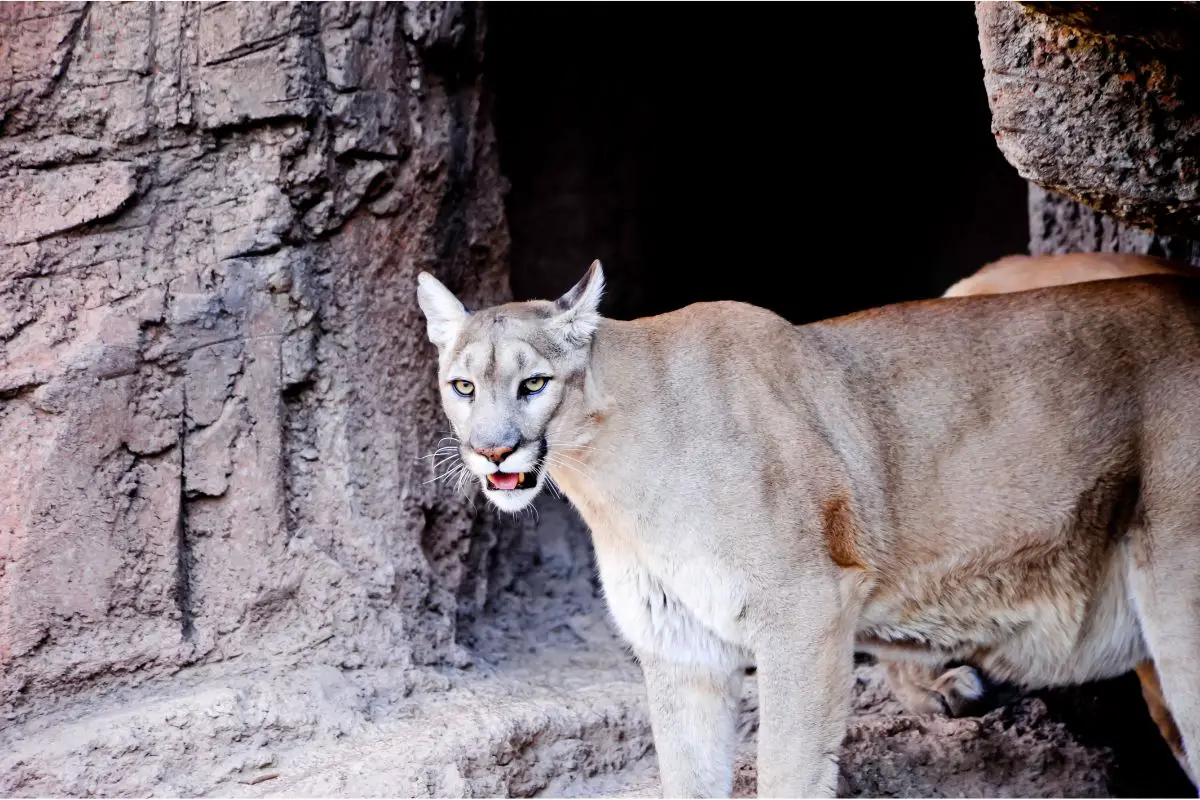
There have been a number of cases where jogging or biking partners have been able to successfully scare off a mountain lion attack by using all the same methods mentioned above.
It is important to never bend down to pick up a rock or something else to throw if it puts you in a vulnerable position.
You should also try to remain standing, or else the cougar will have the advantage of being able to use all four legs to be stronger.
Preventing A Mountain Lion Attack
Prevention is the best cure, and that definitely applies to mountain lions.
If you want to prevent yourself and others from getting attacked by one of these powerful animals, you need to know what to look out for while outdoors.
Chances are, you will start to see signs of cougars in the area as soon as you learn what you should be looking for.
You should also pay close attention to the rangers and all signs that are in place. Too often, people ignore the signs and walk straight into a cougar den.
If you do notice the signs of a mountain lion while out, you should prepare yourself for an attack.
Get your trekking poles out so that you can use them, and ready your bear or pepper spray.
You should go into overdrive and be extremely alert to every single thing around you.
Make a lot of noise, too. While there is a good chance that the mountain lion ran away as soon as you became known to them, others will not.
Here is a list of things that you should look out for while on a trail:
- Perfect Cougar Prey – seeing any kind of animal that would be ideal for a cougar to prey on (sheep, deer, or anything similar are perfect for cougars).
- Animal Carcasses In The Area – seeing animal carcasses, whether they are old or fresh. Mountain lions will happily chow down on a carcass they find, and it doesn’t matter if they killed it or not. They are opportunistic, and the smell of the carcass could easily attract them.
- Mountain Lion Feces – seeing mountain lion feces or scat is a surefire sign that there are mountain lions in the area. This might be difficult to recognize, but it often has hair in it. Other than that, it looks relatively similar to human feces. If the scat is moist and warm, then you could be in danger. If it is old and dry, you could still be in danger.
- Cougar Tracks – seeing cougar tracks in the area is another worrying sign that you could be in danger. Like with the feces, whether the tracks are old or new, you could still be in danger. There could be more tracks in the area that you just can’t see. If the tracks you see are fresh, then it’s time to get the trekking rods and bear spray out.
Even when you are resting, you should be very careful. The smaller the target, the easier they are to kill.
If you make yourself look small, even when you are resting, you become a far more tantalizing option to a cougar.
Always make yourself look big and strong, and you are less likely to be attacked.
One of the scariest aspects of cougar attacks is that they prefer smaller targets.
As such, your pets and children will always be their go-to on the trail.
ALWAYS keep your children and animals close to you.
There have been several attacks where children have died because they walked ahead of their parents on the trail.
Keeping pets safe can be more difficult. There may be times when animals, especially large dogs, can scare a mountain lion off.
There may be other times when your dog looks like the perfect meal for a mountain lion.
You never know which will happen, but there is always a good chance of your dog becoming aware of a mountain lion’s presence before you do.
This can save your life as it will give you some time to protect yourself and others before an attack.
Do Mountain Lions Affect Farming And Livestock?
One of the main reasons that mountain lions are killed is because they pose a threat to livestock and farmers.
It is estimated that mountain lions cause roughly 20% of livestock predation losses in states in the Western United States.
The issue of livestock deaths can be particularly difficult to deal with in states such as Colorado, Nevada, Arizona, and New Mexico due to bighorn sheep.
However, any farms that have horses, cattle, sheep, goats, pigs, chickens or anything else worth eating can suffer.
Attacks on farm animals are unforeseeable, and often happen in quick succession. This can leave farms in debt and suffering in just weeks.
However, there are a number of ways to avoid livestock from being targeted by mountain lions:
- Use Frightening Techniques – the use of night lighting is one of the key components to preventing livestock attacks. This, combined with playing loud music or having a number of loud guard dogs, typically works well. All of these factors have a good chance of scaring away any mountain lion that could attack animals on the farm.
- Use Cultural Methods – mountain lions are stalkers, which means that they often rely on brush or cover to aid them in their hunt. Farmers can remove timber and brush, or any other kind of shelter, from buildings and fields. This ensures that the cougars will have little chance to sneak up on animals and hunt successfully.
- Prevent Access – preventing access to livestock may not always be an option, but should be of utmost importance for animals that are of high value. Use electric fencing and heavy woven wire to keep the mountain lions out, and do checks regularly.
The Impact Of Mountain Lions On The Environment
Mountain lions play a key role in the ecosystem and environment. They keep the ecosystem in check in a number of crucial ways, including:
- Preventing animals such as deer from overgrazing
- Reducing the amount of time that animals spend browning and grazing near streams, which prevents flooding and also droughts
- Provides carrion with food sources from hunting animals
- Enriching soil thanks to the nutrients that come from the prey that the mountain lions take down
- Keep the sizes of deer herds under control. Without controlling deer populations, overgrazing would be a huge issue, as would disease spread.
This keystone species plays a much larger role in keeping the ecosystem healthy than many people give it credit for.
They promote biodiversity and prevent overgrazing and the spread of disease by controlling animal populations in the area.
Did You Know?
- Mountain lions can’t roar, but can purr like house cats.
- Mountain lion sizes typically get smaller the closer to the equator they are, and larger the closer to the poles they are.
- In proportion to their body, pumas have the largest legs of all the cats.
- Cougars can survive and thrive in almost any habitat, from wetlands to mountains and deserts.
- These animals can leap over 40 feet, which is about the same length as a full-sized school bus!
- Mountain lions need 40 times as much territory as bobcats do, and 13 times more than black bears.
Final Thoughts
Mountain lions are incredible animals that are not only beautiful and strong, but they are also important to the ecosystem.
They are primarily found in Western United States, but also South America as far as Chile and Argentina, but also Alaska!
These animals control animal numbers and even prevent overgrazing and flooding.
Overall, mountain lions are animals that deserve to be protected.
Not only because they are a keystone species, but because they are beautiful and simply deserve it.
These animals have lost huge areas of habitat over the years as humans have built more cities and roads.
This has caused a drop in the mountain lion population and could signify something more serious if more measures are not put in place to protect them in the future.
- Bengal Cat vs Wild Bengal Tiger: Complete Comparison 2025 - October 31, 2025
- Complete Wild Cat Spotting Guide for Hikers 2025 - October 31, 2025
- Lynx vs Bobcat: Complete Field Identification Guide 2025 - October 30, 2025



